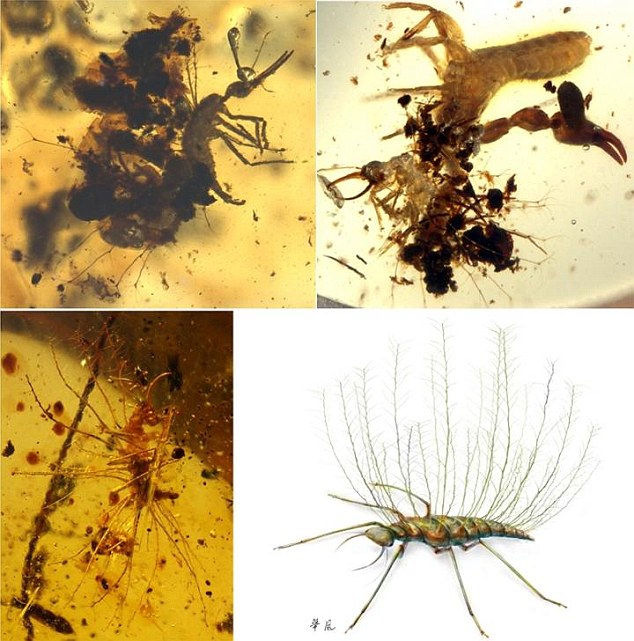June 24, 2016, By SARAH GRIFFITHS FOR MAILONLINE

From disruptive patterns to mimicry, insects’ ability to camouflage themselves from predators has played an important role in their evolutionary success.
Now experts have discovered the oldest known evidence of bugs using ‘debris carrying’ to stay hidden – a clever method still used by some larvae today.
Amber fossils reveal immature lacewings and reduviids (assassin bugs) concealed themselves by carrying grains of sand and soil, leaf fragments and even the exoskeletons of their prey, 100 million years ago.
Debris-carrying, a behaviour of actively harvesting and carrying waste materials, is among the most fascinating and complex behaviours because it requires not only an ability to recognise, collect, and carry materials, but also evolutionary adaptations in related morphological characteristics, so an animal can blend in.
The fossil record, of such behaviour is extremely scarce, with only a single Mesozoic example from Spanish amber known previously
However, now Dr Wang Bo from the Nanjing Institute of Geology and Palaeontology of the Chinese Academy of Sciences and his colleagues have now reported a diverse insect assemblage of exceptionally preserved debris carriers from Cretaceous Burmese, French, and Lebanese ambers.
The fossils include the earliest known chrysopoid larvae (green lacewings), myrmeleontoid larvae (split-footed lacewings and owlflies), and reduviids (assassin bugs).
These ancient insects used a variety of debris material, including insect exoskeletons, sand grains, soil dust, leaf hairs of ferns, wood fibres, and other vegetal debris to cover themselves.
They convergent evolved their debris-carrying behaviour through multiple pathways, giving them plenty of flexibility to evolve and thrive.
The amber fossils demonstrate that the behavioural repertoire, which is associated with considerable bodily adaptations, was already widespread among insects by at least the Mid-Cretaceous, approximately 145 to 66 million years ago.
The findings, published in the journal Science Advances, shed light on the early evolution of camouflage in insects and ancient ecological links between plants and insects.
Most of the Burmese amber lacewing larvae were preserved with dendritic trichomes or tiny hairs produced by gleicheniacean ferns, and two chrysopoid larvae were carrying these trichomes, suggesting that the fossil lacewing larvae were closely associated with the habitats of gleicheniacean ferns.
Gleicheniaceae, or forked ferns were common in many habitats across the world in the Mid-Cretaceous are thought to be among the earliest colonisers after fire events.
The experts believe the presence of gleicheniacean trichomes in the Burmese amber shows there were fires at the time the amber was deposited.
This supports a relationship between fire events and the high production of plant resins and also highlights the importance of wildfires in Mid-Cretaceous pre-angiospermous ecosystems, they say. Al.com.
MODERN 'JUNK BUGS'
The Aphid lion - green lacewing larva - uses dead bodies of other insects to conceal itself.
The insect sucks the innards from prey using horn-like mouth parts and once it's had its fill, flings the drained husks on its back, according to a
Scientists think the insect lugs its kills around on its back to fool birds and predatory ants.
This cunning method of camouflage may also help the insect hunt aphids and the eggs of other bugs.
From: http://www.dailymail.co.uk/sciencetech/article-3658486/Ancient-insects-wore-camouflage-Amber-fossils-reveal-lacewings-carried-rubbish-hide-100-million-years-ago.html
